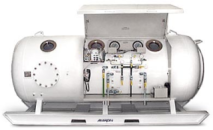Exceptional Blood Loss Anemia

Exceptional blood loss is the most common cause of acute blood loss anemia. The primary risk of exceptional blood loss associated with a reduction in the number of erythrocytes (a Red Blood Cells carrying the oxygen bound to Hemoglobin), which affects blood volume and its consistency.
If plasma were the only vehicle to deliver dissolved oxygen, each 100 ml of blood flowing to an organ system would carry only 0.3 ml of gaseous oxygen. The consumption of oxygen by human tissues far exceeds this. For instance, the kidney extracts approximately 2 ml of oxygen for every 100 ml of blood which circulates through it. From the same 100 ml of blood, the brain extracts approximately 6.5 ml and the heart 10.5 ml of oxygen.
In most instances, humans average 15 grams of hemoglobin per 100 cc of blood. Each gram of hemoglobin transports 1.34 ml of oxygen. This is in addition to the oxygen carried by plasma. So, 100 ml of blood, by containing 15 grams of hemoglobin, can carry approximately 20 ml of gaseous oxygen (1.34 ml X 15 g Hb = 20 ml of oxygen).
The average adult has a total blood volume of approximately 5,000 to 6,000 ml (milliliters) and can usually lose 500 ml of blood without serious or lasting effects; but, if the loss reaches 1,000 ml or more, serious acute consequences may occur.
To compensate a rapid and dangerous reduction in oxygen supply and to maintain adequate volume of blood, a bone marrow accelerates a liquids and electrolytes extraction from tissues and interstitial spaces to expand the volume of plasma and formation of new blood cells.
This action decreases the thickness (viscosity) of blood, causing diluted blood to flow faster and more turbulently than normally and thus increasing the risks of heart problems such as cardiac dilation, heart valve insufficiency and ventricular dysfunction.
Over a short time, severe bleeding may reduce the amount of iron in the body to the extent that the bone marrow is not able to increase production of new red blood cells to replace those lost.
Clinical indications of anemia caused by severe bleeding may be obscured by a cardiovascular problems caused by exceptional blood loss. Severe shock, lactic acidosis, and death may occur if blood loss exceeds 40% to 50% of plasma volume.
Some of the possible heart problems caused by acute blood loss anemia can is the result of hypoxia. This causes all blood vessels to dilate, speeding up the blood flow even more. The venues blood return to the heart increases, the heart works harder and faster trying to prevent cardiopulmonary congestion. All this manifestations can lead to the congestive heart failure.
For large or rapid blood loss, the source of bleeding must be found ASAP and the bleeding stopped. For large blood losses, transfusion of fresh whole blood is the treatment of choice.
©2008 Undersea and Hyperbaric Medical Society, Inc. The book can be purchased at UHMS web site.
By Keith Van Meter, M.D., FACEP
Patients who have marked loss of red blood cell mass by hemorrhage, hemolysis, or aplasia run the risk of lacking adequate oxygen carrying capacity by blood. The more quickly the severe anemia develops, the less tolerant the patient may be of the insult.
Hemoglobin (Hgb), a powerful carrier for oxygen, transports 1.34 ml of oxygen per gram. The amount of oxygen that will dissolve in one milliliter of plasma is 0.003 ml per mmHg of the partial pressure of oxygen (O2) in inhaled gas. CaO2 and CvO2 respectively represent the arterial or venous content of oxygen in blood.
On the average, the body extracts 5 to 6 ml of O2 for every 100 ml of blood that sweeps through the microvasculature of most organ systems. Physiologic normal levels of Hgb readily supply tissue oxygen extraction rates of 5 to 6 volume percent. As Hgb drops to 6 g/dL, oxygen delivery, to offset these baseline oxygen extraction rates, becomes problematic and is clearly inadequate at Hgb levels below 3.6 g/dL.
Accumulative oxygen debt is defined as the time integral of the VO2 measured during and after shock insult minus the baseline VO2 required during the same time interval. Clinical research in evaluation of patients with severe hemorrhage, demonstrates no chance of survival if the accumulative oxygen debt exceeds 33 L/m2. Multiorgan failure (MOF) occurs if the accumulative oxygen debt exceeds 22 L/m2. All patients who have an accumulative oxygen debt of 9 L/m2 survive without residual disability.121
In the 1960s, the Dutch thoracic surgeon Boerema demonstrated that one could exchange transfuse piglets with a simulated plasma mixture of buffered normal saline (Ringers Lactate solution), dextrose and dextran.123 In this process, blood was removed from the blood vessels and the substitute liquid (without hemoglobin) replaced.
He then pressurized the piglets in a hyperbaric chamber while the animals breathed 100% oxygen. By the trick of pressurization, enough oxygen could be dissolved in the simulated plasma mixture to supply tissue oxygen requirements. This was enough to adequately sustain the animal, as evidenced by the fact that the animals survived and could be brought out of the chamber to be successfully re-exchange transfused with their previously extracted blood.
As Hyperbaric Oxygen (or for that matter normobaric oxygen) administered for long periods can become toxic, intermittent administration of HBO2 is essential. This point has been demonstrated clinically by the American thoracic surgeon, George Hart. In 1974, he reported a series of 26 severe blood loss patients who were treated with HBO2 as an alternative to otherwise disallowed red blood cell transfusion. The survival rate was 70%.
Alternative approaches include use of fluorocarbons or stroma-free hemoglobin. While potentially promising, these treatment solutions still pose uncertainties for their potential ability to unfavorably alter the immune system. While erythropoietin may be used to stimulate the bone marrow to produce RBCs, HBO2 therapy only complements its use in exceptional blood loss anemia.












